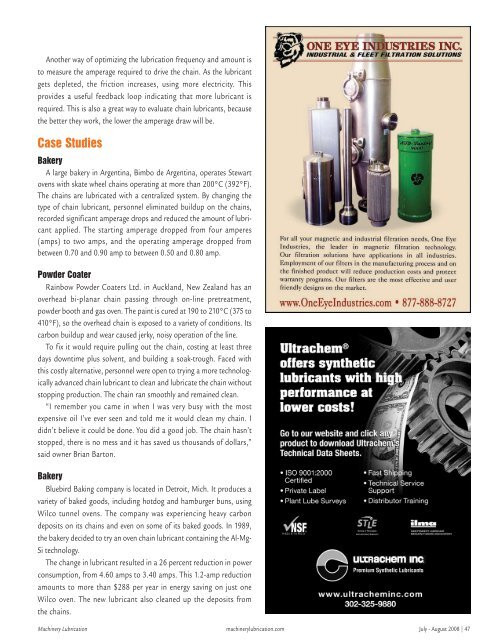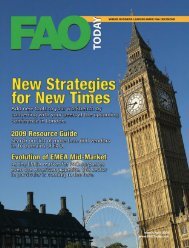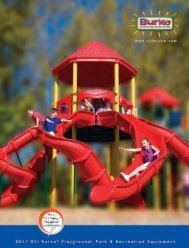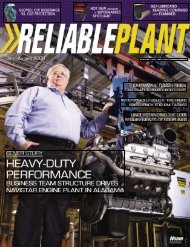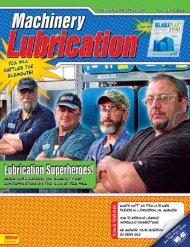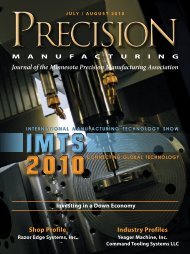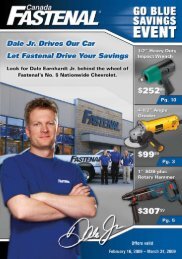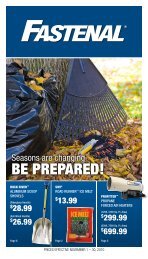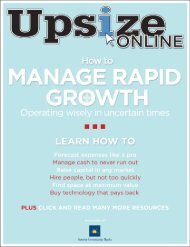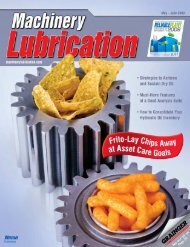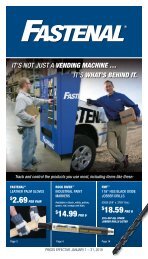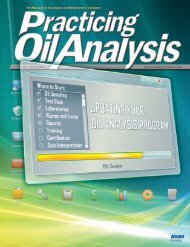Machinery Lubrication July August 2008
Machinery Lubrication July August 2008
Machinery Lubrication July August 2008
You also want an ePaper? Increase the reach of your titles
YUMPU automatically turns print PDFs into web optimized ePapers that Google loves.
Another way of optimizing the lubrication frequency and amount is<br />
to measure the amperage required to drive the chain. As the lubricant<br />
gets depleted, the friction increases, using more electricity. This<br />
provides a useful feedback loop indicating that more lubricant is<br />
required. This is also a great way to evaluate chain lubricants, because<br />
the better they work, the lower the amperage draw will be.<br />
Case Studies<br />
Bakery<br />
A large bakery in Argentina, Bimbo de Argentina, operates Stewart<br />
ovens with skate wheel chains operating at more than 200°C (392°F).<br />
The chains are lubricated with a centralized system. By changing the<br />
type of chain lubricant, personnel eliminated buildup on the chains,<br />
recorded significant amperage drops and reduced the amount of lubricant<br />
applied. The starting amperage dropped from four amperes<br />
(amps) to two amps, and the operating amperage dropped from<br />
between 0.70 and 0.90 amp to between 0.50 and 0.80 amp.<br />
Powder Coater<br />
Rainbow Powder Coaters Ltd. in Auckland, New Zealand has an<br />
overhead bi-planar chain passing through on-line pretreatment,<br />
powder booth and gas oven. The paint is cured at 190 to 210°C (375 to<br />
410°F), so the overhead chain is exposed to a variety of conditions. Its<br />
carbon buildup and wear caused jerky, noisy operation of the line.<br />
To fix it would require pulling out the chain, costing at least three<br />
days downtime plus solvent, and building a soak-trough. Faced with<br />
this costly alternative, personnel were open to trying a more technologically<br />
advanced chain lubricant to clean and lubricate the chain without<br />
stopping production. The chain ran smoothly and remained clean.<br />
“I remember you came in when I was very busy with the most<br />
expensive oil I’ve ever seen and told me it would clean my chain. I<br />
didn’t believe it could be done. You did a good job. The chain hasn’t<br />
stopped, there is no mess and it has saved us thousands of dollars,”<br />
said owner Brian Barton.<br />
Bakery<br />
Bluebird Baking company is located in Detroit, Mich. It produces a<br />
variety of baked goods, including hotdog and hamburger buns, using<br />
Wilco tunnel ovens. The company was experiencing heavy carbon<br />
deposits on its chains and even on some of its baked goods. In 1989,<br />
the bakery decided to try an oven chain lubricant containing the Al-Mg-<br />
Si technology.<br />
The change in lubricant resulted in a 26 percent reduction in power<br />
consumption, from 4.60 amps to 3.40 amps. This 1.2-amp reduction<br />
amounts to more than $288 per year in energy saving on just one<br />
Wilco oven. The new lubricant also cleaned up the deposits from<br />
the chains.<br />
<strong>Machinery</strong> <strong>Lubrication</strong> machinerylubrication.com <strong>July</strong> - <strong>August</strong> <strong>2008</strong> 47


